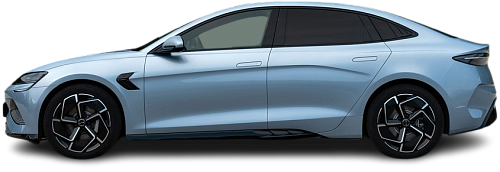Global EV Comparison: BMW i5 eDrive40 vs BYD Seal Design RWD
Struggling to Decide? Let AI Help!
Your AI Summary Is Ready!
General Info
The BYD Seal Design RWD (2022-…) is currently produced, it has a starting price of €44990. The BMW i5 eDrive40 (2023-2025) has been discontinued. You can find it for as low as €54889 on the used car market.
The two vehicles share the same body style: Sedan.
| Property | BMW i5 eDrive40 | BYD Seal Design RWD |
|---|---|---|
| Years of Production | 2023-2025 | 2022-… |
| Current Status | Discontinued | Produced |
| Country of Manufacture | Germany, China | China |
| Body Style | Sedan | Sedan |
| Market Availability | EU, USA | EU |
| Price Europe (New) | - Price Europe (New) | €44990 |
| Price Europe (Used) | €54889 | €38440 |
| GCC Score | 6.6 | 6.5 |
Range and Efficiency
The BYD Seal Design RWD (2022-…) boasts a greater real-world range, a larger battery, and superior energy efficiency compared to the BMW i5 eDrive40 (2023-2025).
| Property | BMW i5 eDrive40 | BYD Seal Design RWD |
|---|---|---|
| Range (EPA) | 475 km | - Range (EPA) |
| Range (WLTP) | 582 km | 570 km |
| Range (GCC) | 464 km | 485 km |
| Battery Capacity (Nominal) | 84.4 kWh | 84 kWh |
| Battery Capacity (Usable) | 81.2 kWh | 82.5 kWh |
| Efficiency per 100 km | 17.5 kWh/100 km | 17 kWh/100 km |
| Efficiency per kWh | 5.71 km/kWh | 5.88 km/kWh |
| Range and Efficiency Score | 7.7 | 8.2 |
Charging
Both vehicles utilize a standard 400-volt architecture.
The BMW i5 eDrive40 (2023-2025) offers faster charging speeds at DC stations, reaching up to 206 kW, while the BYD Seal Design RWD (2022-…) maxes out at 150 kW.
Both vehicles are equipped with the same on-board charger, supporting a maximum AC charging power of 11 kW.
| Property | BMW i5 eDrive40 | BYD Seal Design RWD |
|---|---|---|
| Max Charging Power (AC) | 11 kW | 11 kW |
| Max Charging Power (DC) | 206 kW | 150 kW |
| Architecture | 400 V | 400 V |
| Charge Port | CCS Type 2 | CCS Type 2 |
| Charging Score | 6.9 | 6.5 |
Performance
Both vehicles are rear-wheel drive.
Although the BMW i5 eDrive40 (2023-2025) has more power, the BYD Seal Design RWD (2022-…) achieves a faster 0-100 km/h time.
| Property | BMW i5 eDrive40 | BYD Seal Design RWD |
|---|---|---|
| Drive Type | RWD | RWD |
| Motor Type | PMSM | PMSM |
| Motor Power (kW) | 250 kW | 230 kW |
| Motor Power (hp) | 335 hp | 308 hp |
| Motor Torque | 430 Nm | 360 Nm |
| 0-100 km/h | 6 s | 5.9 s |
| Top Speed | 193 km/h | 180 km/h |
| Performance Score | 4.8 | 4.5 |
Dimensions
The BMW i5 eDrive40 (2023-2025) is longer and taller, but about the same width as the BYD Seal Design RWD (2022-…).
The BMW i5 eDrive40 (2023-2025) boasts a more extended wheelbase.
| Property | BMW i5 eDrive40 | BYD Seal Design RWD |
|---|---|---|
| Length | 5060 mm | 4800 mm |
| Width (with Mirrors) | 2156 mm | 2150 mm |
| Width (w/o Mirrors) | 1900 mm | 1875 mm |
| Height | 1515 mm | 1460 mm |
| Wheelbase | 2995 mm | 2920 mm |
Cargo and Towing
A frunk (front trunk) is available in the BYD Seal Design RWD (2022-…), but the BMW i5 eDrive40 (2023-2025) doesn’t have one.
The BMW i5 eDrive40 (2023-2025) is better suited for heavy loads, offering a greater towing capacity than the BYD Seal Design RWD (2022-…).
| Property | BMW i5 eDrive40 | BYD Seal Design RWD |
|---|---|---|
| Number of Seats | 5 | 5 |
| Curb Weight | 2205 kg | 2055 kg |
| Cargo Volume (Trunk) | 490 l | 400 l |
| Cargo Volume (Max) | 785 l | - Cargo Volume (Max) |
| Cargo Volume (Frunk) | - Cargo Volume (Frunk) | 53 l |
| Towing Capacity | 1500 kg | 750 kg |
| Cargo and Towing Score | 5.8 | 5.3 |




